Yuanheng Zhu
Empowering Multi-Robot Cooperation via Sequential World Models
Sep 16, 2025Abstract:Model-based reinforcement learning (MBRL) has shown significant potential in robotics due to its high sample efficiency and planning capability. However, extending MBRL to multi-robot cooperation remains challenging due to the complexity of joint dynamics. To address this, we propose the Sequential World Model (SeqWM), a novel framework that integrates the sequential paradigm into model-based multi-agent reinforcement learning. SeqWM employs independent, sequentially structured agent-wise world models to decompose complex joint dynamics. Latent rollouts and decision-making are performed through sequential communication, where each agent generates its future trajectory and plans its actions based on the predictions of its predecessors. This design enables explicit intention sharing, enhancing cooperative performance, and reduces communication overhead to linear complexity. Results in challenging simulated environments (Bi-DexHands and Multi-Quad) show that SeqWM outperforms existing state-of-the-art model-free and model-based baselines in both overall performance and sample efficiency, while exhibiting advanced cooperative behaviors such as predictive adaptation and role division. Furthermore, SeqWM has been success fully deployed on physical quadruped robots, demonstrating its effectiveness in real-world multi-robot systems. Demos and code are available at: https://github.com/zhaozijie2022/seqwm-marl
SRFT: A Single-Stage Method with Supervised and Reinforcement Fine-Tuning for Reasoning
Jun 24, 2025Abstract:Large language models (LLMs) have achieved remarkable progress in reasoning tasks, yet the optimal integration of Supervised Fine-Tuning (SFT) and Reinforcement Learning (RL) remains a fundamental challenge. Through comprehensive analysis of token distributions, learning dynamics, and integration mechanisms from entropy-based perspectives, we reveal key differences between these paradigms: SFT induces coarse-grained global changes to LLM policy distributions, while RL performs fine-grained selective optimizations, with entropy serving as a critical indicator of training effectiveness. Building on these observations, we propose Supervised Reinforcement Fine-Tuning (SRFT), a single-stage method that unifies both fine-tuning paradigms through entropy-aware weighting mechanisms. Our approach simultaneously applies SFT and RL to directly optimize the LLM using demonstrations and self-exploration rollouts rather than through two-stage sequential methods. Extensive experiments show that SRFT achieves 59.1% average accuracy, outperforming zero-RL methods by 9.0% on five mathematical reasoning benchmarks and 10.9% on three out-of-distribution benchmarks.
DipLLM: Fine-Tuning LLM for Strategic Decision-making in Diplomacy
Jun 11, 2025Abstract:Diplomacy is a complex multiplayer game that requires both cooperation and competition, posing significant challenges for AI systems. Traditional methods rely on equilibrium search to generate extensive game data for training, which demands substantial computational resources. Large Language Models (LLMs) offer a promising alternative, leveraging pre-trained knowledge to achieve strong performance with relatively small-scale fine-tuning. However, applying LLMs to Diplomacy remains challenging due to the exponential growth of possible action combinations and the intricate strategic interactions among players. To address this challenge, we propose DipLLM, a fine-tuned LLM-based agent that learns equilibrium policies for Diplomacy. DipLLM employs an autoregressive factorization framework to simplify the complex task of multi-unit action assignment into a sequence of unit-level decisions. By defining an equilibrium policy within this framework as the learning objective, we fine-tune the model using only 1.5% of the data required by the state-of-the-art Cicero model, surpassing its performance. Our results demonstrate the potential of fine-tuned LLMs for tackling complex strategic decision-making in multiplayer games.
Meta-DT: Offline Meta-RL as Conditional Sequence Modeling with World Model Disentanglement
Oct 15, 2024Abstract:A longstanding goal of artificial general intelligence is highly capable generalists that can learn from diverse experiences and generalize to unseen tasks. The language and vision communities have seen remarkable progress toward this trend by scaling up transformer-based models trained on massive datasets, while reinforcement learning (RL) agents still suffer from poor generalization capacity under such paradigms. To tackle this challenge, we propose Meta Decision Transformer (Meta-DT), which leverages the sequential modeling ability of the transformer architecture and robust task representation learning via world model disentanglement to achieve efficient generalization in offline meta-RL. We pretrain a context-aware world model to learn a compact task representation, and inject it as a contextual condition to the causal transformer to guide task-oriented sequence generation. Then, we subtly utilize history trajectories generated by the meta-policy as a self-guided prompt to exploit the architectural inductive bias. We select the trajectory segment that yields the largest prediction error on the pretrained world model to construct the prompt, aiming to encode task-specific information complementary to the world model maximally. Notably, the proposed framework eliminates the requirement of any expert demonstration or domain knowledge at test time. Experimental results on MuJoCo and Meta-World benchmarks across various dataset types show that Meta-DT exhibits superior few and zero-shot generalization capacity compared to strong baselines while being more practical with fewer prerequisites. Our code is available at https://github.com/NJU-RL/Meta-DT.
Discretizing Continuous Action Space with Unimodal Probability Distributions for On-Policy Reinforcement Learning
Aug 01, 2024Abstract:For on-policy reinforcement learning, discretizing action space for continuous control can easily express multiple modes and is straightforward to optimize. However, without considering the inherent ordering between the discrete atomic actions, the explosion in the number of discrete actions can possess undesired properties and induce a higher variance for the policy gradient estimator. In this paper, we introduce a straightforward architecture that addresses this issue by constraining the discrete policy to be unimodal using Poisson probability distributions. This unimodal architecture can better leverage the continuity in the underlying continuous action space using explicit unimodal probability distributions. We conduct extensive experiments to show that the discrete policy with the unimodal probability distribution provides significantly faster convergence and higher performance for on-policy reinforcement learning algorithms in challenging control tasks, especially in highly complex tasks such as Humanoid. We provide theoretical analysis on the variance of the policy gradient estimator, which suggests that our attentively designed unimodal discrete policy can retain a lower variance and yield a stable learning process.
FM3Q: Factorized Multi-Agent MiniMax Q-Learning for Two-Team Zero-Sum Markov Game
Feb 01, 2024Abstract:Many real-world applications involve some agents that fall into two teams, with payoffs that are equal within the same team but of opposite sign across the opponent team. The so-called two-team zero-sum Markov games (2t0sMGs) can be resolved with reinforcement learning in recent years. However, existing methods are thus inefficient in light of insufficient consideration of intra-team credit assignment, data utilization and computational intractability. In this paper, we propose the individual-global-minimax (IGMM) principle to ensure the coherence between two-team minimax behaviors and the individual greedy behaviors through Q functions in 2t0sMGs. Based on it, we present a novel multi-agent reinforcement learning framework, Factorized Multi-Agent MiniMax Q-Learning (FM3Q), which can factorize the joint minimax Q function into individual ones and iteratively solve for the IGMM-satisfied minimax Q functions for 2t0sMGs. Moreover, an online learning algorithm with neural networks is proposed to implement FM3Q and obtain the deterministic and decentralized minimax policies for two-team players. A theoretical analysis is provided to prove the convergence of FM3Q. Empirically, we use three environments to evaluate the learning efficiency and final performance of FM3Q and show its superiority on 2t0sMGs.
NeuronsMAE: A Novel Multi-Agent Reinforcement Learning Environment for Cooperative and Competitive Multi-Robot Tasks
Mar 22, 2023Abstract:Multi-agent reinforcement learning (MARL) has achieved remarkable success in various challenging problems. Meanwhile, more and more benchmarks have emerged and provided some standards to evaluate the algorithms in different fields. On the one hand, the virtual MARL environments lack knowledge of real-world tasks and actuator abilities, and on the other hand, the current task-specified multi-robot platform has poor support for the generality of multi-agent reinforcement learning algorithms and lacks support for transferring from simulation to the real environment. Bridging the gap between the virtual MARL environments and the real multi-robot platform becomes the key to promoting the practicability of MARL algorithms. This paper proposes a novel MARL environment for real multi-robot tasks named NeuronsMAE (Neurons Multi-Agent Environment). This environment supports cooperative and competitive multi-robot tasks and is configured with rich parameter interfaces to study the multi-agent policy transfer from simulation to reality. With this platform, we evaluate various popular MARL algorithms and build a new MARL benchmark for multi-robot tasks. We hope that this platform will facilitate the research and application of MARL algorithms for real robot tasks. Information about the benchmark and the open-source code will be released.
A Hierarchical Deep Reinforcement Learning Framework for 6-DOF UCAV Air-to-Air Combat
Dec 05, 2022



Abstract:Unmanned combat air vehicle (UCAV) combat is a challenging scenario with continuous action space. In this paper, we propose a general hierarchical framework to resolve the within-vision-range (WVR) air-to-air combat problem under 6 dimensions of degree (6-DOF) dynamics. The core idea is to divide the whole decision process into two loops and use reinforcement learning (RL) to solve them separately. The outer loop takes into account the current combat situation and decides the expected macro behavior of the aircraft according to a combat strategy. Then the inner loop tracks the macro behavior with a flight controller by calculating the actual input signals for the aircraft. We design the Markov decision process for both the outer loop strategy and inner loop controller, and train them by proximal policy optimization (PPO) algorithm. For the inner loop controller, we design an effective reward function to accurately track various macro behavior. For the outer loop strategy, we further adopt a fictitious self-play mechanism to improve the combat performance by constantly combating against the historical strategies. Experiment results show that the inner loop controller can achieve better tracking performance than fine-tuned PID controller, and the outer loop strategy can perform complex maneuvers to get higher and higher winning rate, with the generation evolves.
Enhanced Rolling Horizon Evolution Algorithm with Opponent Model Learning: Results for the Fighting Game AI Competition
Mar 31, 2020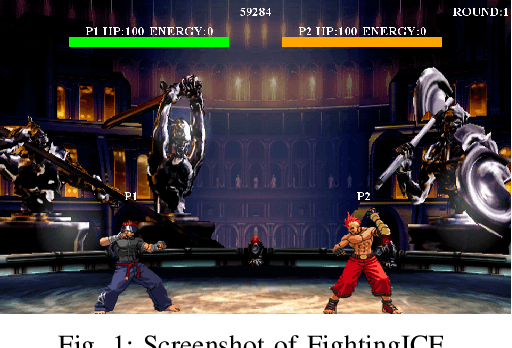
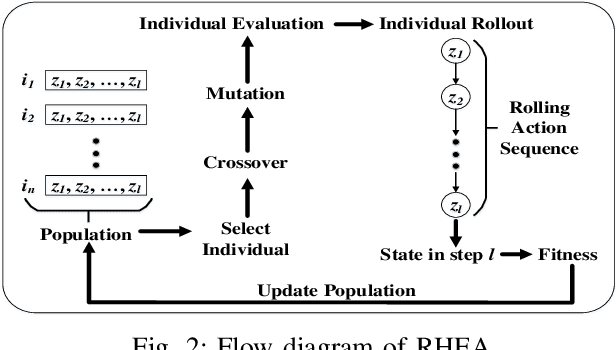
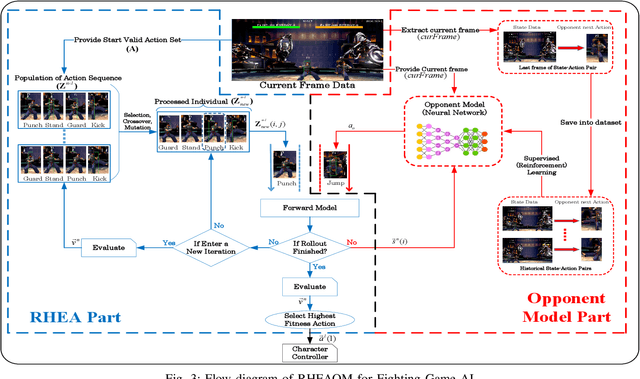
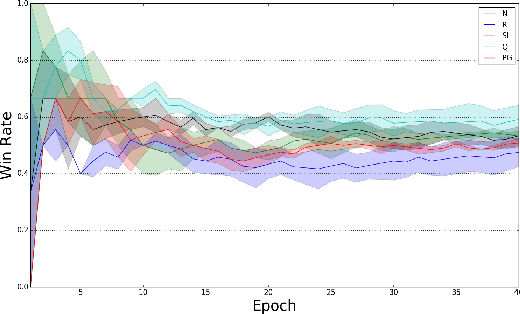
Abstract:The Fighting Game AI Competition (FTGAIC) provides a challenging benchmark for 2-player video game AI. The challenge arises from the large action space, diverse styles of characters and abilities, and the real-time nature of the game. In this paper, we propose a novel algorithm that combines Rolling Horizon Evolution Algorithm (RHEA) with opponent model learning. The approach is readily applicable to any 2-player video game. In contrast to conventional RHEA, an opponent model is proposed and is optimized by supervised learning with cross-entropy and reinforcement learning with policy gradient and Q-learning respectively, based on history observations from opponent. The model is learned during the live gameplay. With the learned opponent model, the extended RHEA is able to make more realistic plans based on what the opponent is likely to do. This tends to lead to better results. We compared our approach directly with the bots from the FTGAIC 2018 competition, and found our method to significantly outperform all of them, for all three character. Furthermore, our proposed bot with the policy-gradient-based opponent model is the only one without using Monte-Carlo Tree Search (MCTS) among top five bots in the 2019 competition in which it achieved second place, while using much less domain knowledge than the winner.
A Survey of Deep Reinforcement Learning in Video Games
Dec 26, 2019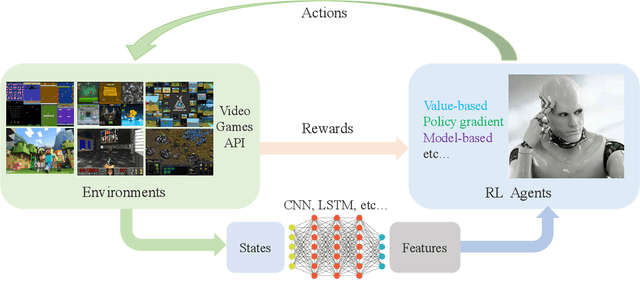

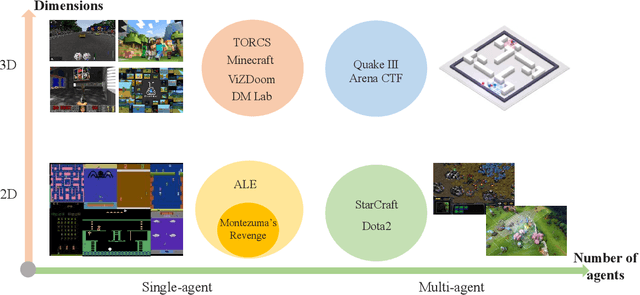
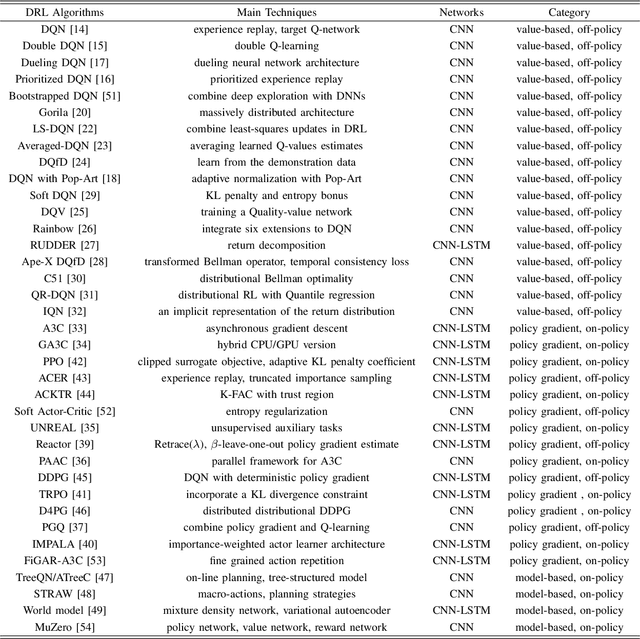
Abstract:Deep reinforcement learning (DRL) has made great achievements since proposed. Generally, DRL agents receive high-dimensional inputs at each step, and make actions according to deep-neural-network-based policies. This learning mechanism updates the policy to maximize the return with an end-to-end method. In this paper, we survey the progress of DRL methods, including value-based, policy gradient, and model-based algorithms, and compare their main techniques and properties. Besides, DRL plays an important role in game artificial intelligence (AI). We also take a review of the achievements of DRL in various video games, including classical Arcade games, first-person perspective games and multi-agent real-time strategy games, from 2D to 3D, and from single-agent to multi-agent. A large number of video game AIs with DRL have achieved super-human performance, while there are still some challenges in this domain. Therefore, we also discuss some key points when applying DRL methods to this field, including exploration-exploitation, sample efficiency, generalization and transfer, multi-agent learning, imperfect information, and delayed spare rewards, as well as some research directions.
 Add to Chrome
Add to Chrome Add to Firefox
Add to Firefox Add to Edge
Add to Edge